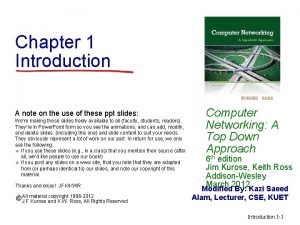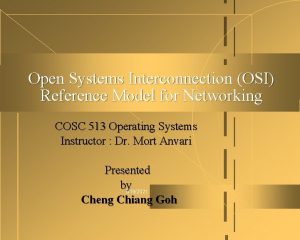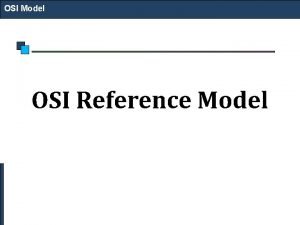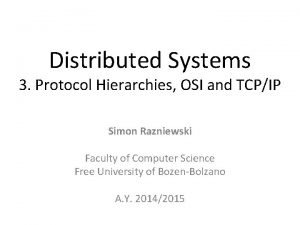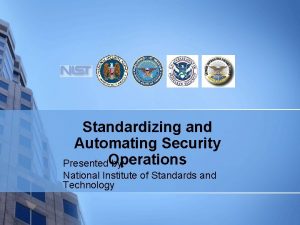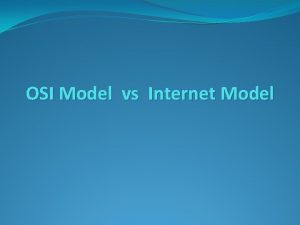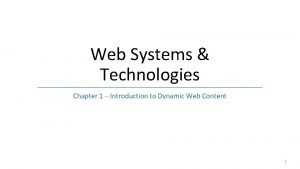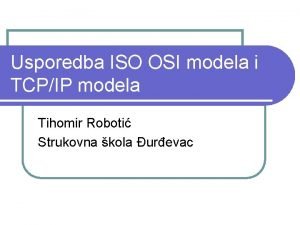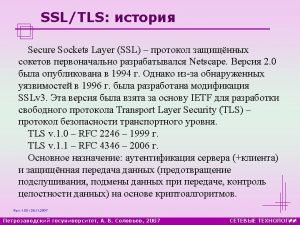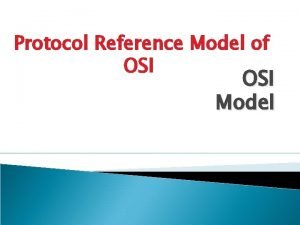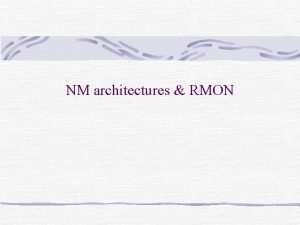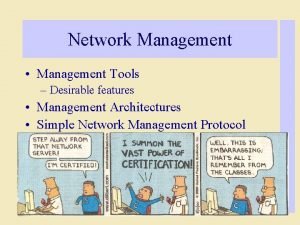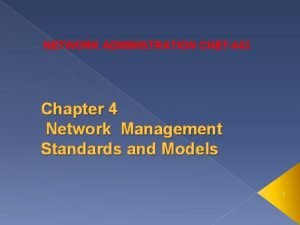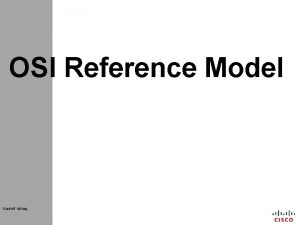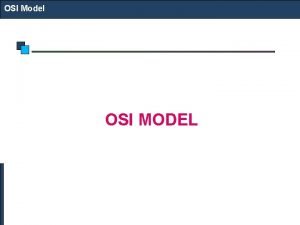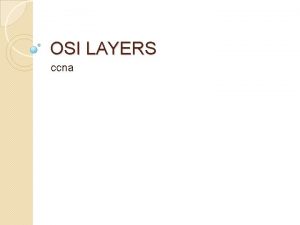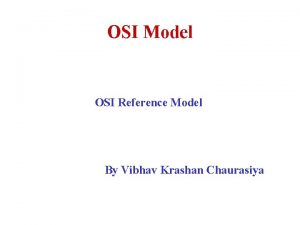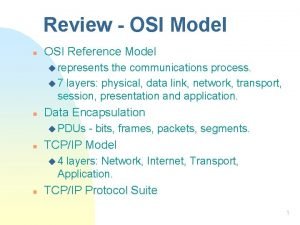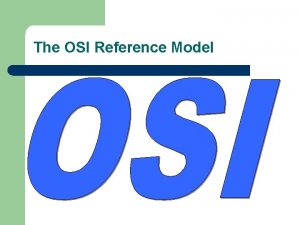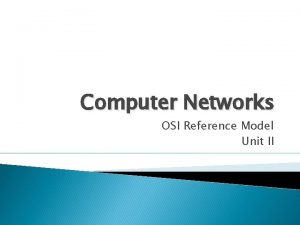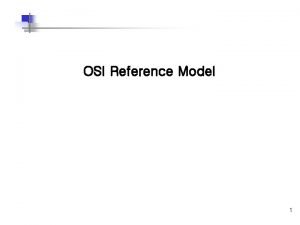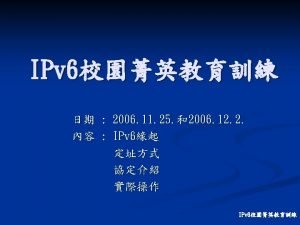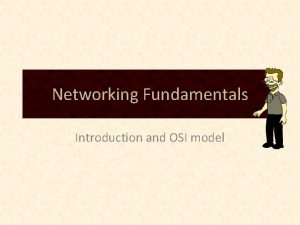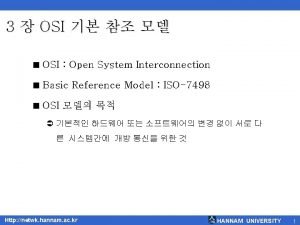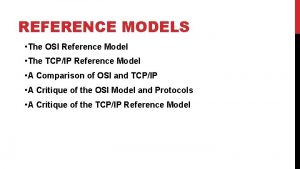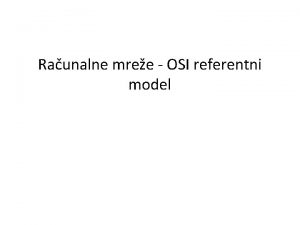Protocol Reference Model of OSI Model Content Introduction




























- Slides: 28

Protocol Reference Model of OSI Model

Content Introduction to the OSI layer How OSI was created and why Comparison with TCP/IP Layers : Application layer Presentation layer Session layer Transport layer Network layer Data link layer Physical layer Conclusion Resources

Introduction to the OSI layer Open Systems Interconnection (OSI) Each layer support the layers above it and offers services to the layers below Each layer performs unique and specific task A layer only has knowledge of its neighbour layers only A layer service is independent of the implementation

How OSI was created and how An attempt for a framework for developing networking technologies OSI became a tool for explaining the Networking in general Before OSI was created people created their Software/Hardware as they wanted it to be. There was not any compatibility. Now OSI is used as a rule set for all vendors to create their Software/Hardware by using the standards.

Protocol Reference Model of OSI II OSI Overview 1. OSI - layered framework for the design of network systems that allows communication across all types of computer systems. 2. The OSI 7 Layers. ( Brief functional overview. ) 3. Vertical and horizontal communication between the layers using interfaces. (defines what information and services should the layer provide to the layer above it. )

Layers Each layer contains a logical grouping of functions Each function receive an input(one or more) and produces an output

Protocol Reference Model of OSI I History 1. The need for standardization - many vendors, no interoperability - no common framework 2. ISO and CCITT came up with OSI (Open System Intercommunication) in 1984. 3. OSI Protocol Suite – unaccepted by vendors and users. (TCP won) 4. OSI – a standard, which allows communication between different systems without requiring changes to the logic of the underlying hardware and software.

Protocol Reference Model of OSI Layer abstraction and the path of the message

Protocol Reference Model of OSI Overview 4. Data Encapsulation a) PDU conception – each protocol on the diff. layer has its own format. b) Headers are added while a packet is going down the stack at each layer. c) Trailers are usually added on the second layer.

Comparison with TCP/IP Pretty similar to OSI TCP/IP has less layers(four) Main difference in layers is after layer 4

Layers

Application layer(Layer 7) Applications and Services run on it Enables human network to interface the underlying data network Applications on that layer (E-mail clients, web browsers, Chats, etc. ) – top-stack applications (As people are on the top of the stack) Applications provide people with a way to create message Application layer services establish an interface to the network Protocols provide the rules and formats that govern how data is treated Protocols on the destination and the host must match

Protocol Reference Model of OSI III The OSI Layers 7. Application Layer ◦ ◦ ◦ ◦ ◦ Provides user interfaces and support for services Resource sharing and device redirection Remote file access Remote printer access Inter-process communication Network management Directory services Electronic messaging (such as mail) Network virtual terminals

Presentation layer(Layer 6) Coding and conversion of Application layer data to ensure that data from the source device can be interpreted by the appropriate application on the destination device. Compression of the data in a manner that can be decompressed by the destination device. Encryption of the data for transmission and the decryption of data upon receipt by the destination. This is the layer at which application programmers consider data structure and presentation Examples: GIF, JPEG, TIFF, etc. Sometimes n distinction is made between the presentation and application layers. For example http/https. HTTP is generally regarded as an application layer protocol although it has Presentation layer aspects such as the ability t identify character encoding for roper conversion

Protocol Reference Model of OSI The OSI Layers 6. Presentation Layer ◦ ◦ ◦ Translation (connects different computer systems) Compression (transmission efficiency) Encryption (SSL security)

Session layer(Layer 5) Functions at this layer create and maintain dialogs between source and destination applications Authentication Permissions Session Restoration (Checkpoint or recovery)

Protocol Reference Model of OSI The OSI Layers 5. Session Layer ◦ ◦ Session establishment, maintenance and termination (Deciding who sends, and when. ) Session support (security, name recognition, logging )

Transport layer(Layer 4) Tracking the individual communication between applications on the source and destination hosts Segmenting data and managing each piece Reassembling the segments into streams of application data Identifying the different applications Conversation Multiplexing Segments Connection-oriented conversations Reliable delivery Ordered data reconstruction Flow control TCP – Web Browser UDP – Video Streaming Applications

Protocol Reference Model of OSI The OSI Layers 4. Transport Layer ◦ ◦ ◦ ◦ Connectionless and connectionoriented services Process-Level Addressing Multiplexing and Demultiplexing Segmentation, Packaging and Reassembly Connection Establishment, Management and Termination Acknowledgments and Retransmissions Flow Control

Network layer(Layer 3) Addressing (IPV 4) Encapsulation (Inserts a header with source and destination IPs) Routing (Move a packet over the Internet) Decapsulation (Open the packet and check the destination host) IP is connectionless

Protocol Reference Model of OSI The OSI Layers 3. Network Layer ◦ ◦ ◦ Logical Addressing Routing (where the packet is destinated to) Datagram Encapsulation Fragmentation and Reassembly (handling too big packets ) Error Handling and Diagnostics ( using status messages for example )

Protocol Reference Model of OSI End to end packet delivery

Data link layer(Layer 2) It is the role of the OSI Data Link layer to prepare Network layer packets for transmission and to control access to the physical media. Allows the upper layers to access the media using techniques such as framing Controls how data is placed onto the media and is received from the media using techniques such as media access control and error detection Frame - The Data Link layer PDU Node - The Layer 2 notation for network devices connected to a common medium Media/medium - The physical means for the transfer of information between two nodes Network - Two or more nodes connected to a common medium The Data Link layer is responsible for the exchange of frames between nodes over the media of a physical network.

Protocol Reference Model of OSI The OSI Layers 2. Data Link Layer 2. 1. Logical Link Control (LLC ) ◦ Establishment and control of logical links between local devices on a network. 2. 2. Media Access Control (MAC) ◦ ◦ • • • The procedures used by devices to control access to the network medium. Frame sequencing Frame acknowledgment Addressing Frame delimiting Frame error checking PDU: frame

Physical layer (Layer 1) The role of the Physical layer is to encode the binary digits that represent Data Link layer frames into signals and to transmit and receive these signals across the physical media that connect network devices. Copper cable Fiber Wireless

Protocol Reference Model of OSI The OSI Layers 1. Physical Layer • Definition of Hardware Specifications (of cables, connectors, wireless radio transceivers, network interface cards ) Encoding and Signaling (bit representation) • Data Transmission and Reception (half duplex, full duplex ) • Topology and Physical Network Design (mesh, ring, bus) 1. PDU: bit •

Protocol Reference Model of OSI Summary

Conclusion The way people learn Networking A standard for software A standard for hardware Seven layers architecture Each layer independent on the others Similar to TCP/IP(TCP/IP explained) OSI is used as a model for developing network aware applications(Here I mean that people use its structure to model software)
 Osi reference model ppt
Osi reference model ppt They relay packets among multiple interconnected networks
They relay packets among multiple interconnected networks Define osi reference model
Define osi reference model Disadvantages of osi reference model
Disadvantages of osi reference model Ftp iso osi
Ftp iso osi Osi model
Osi model Why and when osi reference model was invented
Why and when osi reference model was invented Scorm model
Scorm model Security content automation protocol (scap)
Security content automation protocol (scap) What is esp
What is esp Dynamic content vs static content
Dynamic content vs static content Kyoto protocol reference manual
Kyoto protocol reference manual Osi model vs internet model
Osi model vs internet model Reference node and non reference node
Reference node and non reference node Reference node and non reference node
Reference node and non reference node Introduction to dynamic web content
Introduction to dynamic web content Content management system features
Content management system features Introduction to dynamic web content
Introduction to dynamic web content Content in introduction
Content in introduction Iso/osi
Iso/osi Tcpip
Tcpip Osi tls
Osi tls Osi network management model
Osi network management model Osi
Osi Osi network management model
Osi network management model Osi network management model
Osi network management model Iso network management model
Iso network management model Network management and administration
Network management and administration Osi-iso
Osi-iso

